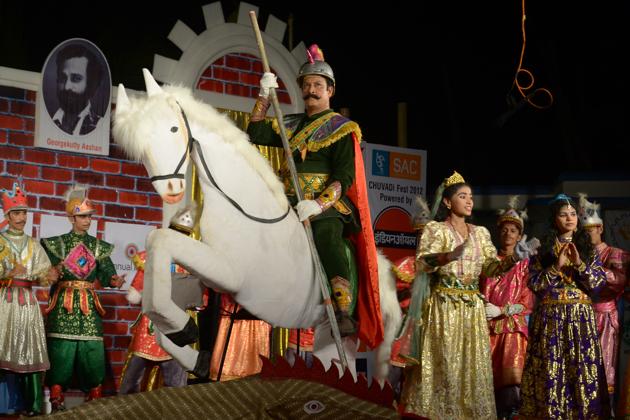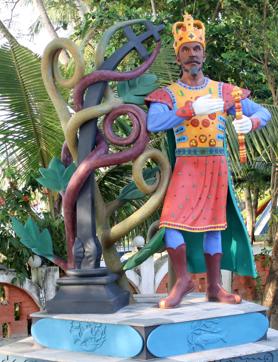Crowns, capes, opera and Kathakali are merging on stage in Kerala
The stamping dance, a Portuguese-era art form, is making a comeback.
As dusk settles, 22 men gather at a training centre in Gothuruth, an island village in the Periyar River about 38 km from Kochi. In the group are fishermen, farmers and construction workers between the ages of 20 and 50.

They’re dressed in pearl-studded crowns and shimmery cloaks embellished with tassels. Soon, the air is filled with the sound of drums, cymbals and battle cries as they rehearse a scene about a French emperor going to war.
It feels very much like an opera, but most of the lines are a mix of Malayalam and Tamil. Actors brandish swords using gestures borrowed from Kalaripayattu. And when their faces flare up in rage, they mirror a Kathakali dancer’s.
This unusual mix of Indian and Western elements is the essence of Chavittu Natakam or the Stamping Dance, a theatre form introduced by Portuguese missionaries to coastal Kerala in the 16th century.
There are only about a dozen troupes in this belt — Gothuruth-Kochi-Alappuzha — that still perform this vibrant type of dance-drama. Gothuruth, home to about 8,000 people, is its epicentre.
In 2014, Ramachandran K, director of the Keli cultural NGO, invited a troupe from Gothuruth to Mumbai to perform at the annual Keli festival. The performance created ripples in the world of cultural heritage. “We had a packed house for all shows. Chavittu Natakam has a significant place in India’s maritime art history but the audience wasn’t even aware it existed,” Ramachandran says.
In December, one of the two remaining troupes in Gothuruth — the Yuvajana Chavittunadaka Kala Samithy — will perform at the multidisciplinary Serendipity Arts Festival (SAF) in Goa.
“This dance form is different from anything else that you see in the country,” says Leela Samson, Bharatanatyam exponent and a curator at SAF. “It’s European in its origin and celebrates the battles of a bygone era. What’s even more interesting is that though Kerala was never a colony, and Goa and Daman were, the locals there didn’t inherit an art form like this. Kerala is the only state where it is practised.”

KNIGHTS & LEGENDS
“Research suggests that the dance form was intended to distinguish the Latin Christians of this region from the St Thomas Christians. It also filled a vacuum in these Christians’ cultural lives since they were forbidden from participating in Hindu rituals,” Ramachandran says.
Instead of transplanting the theatre in its European form, the missionaries merged local elements. “The stories, featuring Biblical themes, were derived from the West but the scripts were written in Senthamil, a mixture of ancient Tamil and Malayalam spoken locally then,” says Thampi Payyapilly, 53, a fourth-generation performer and director of Yuvajana samithy. “The drama retained the Opera style of performance and European costumes but the movements and expressions were influenced by local art forms.”
One of the most popular acts is Karalsman, a story based on the heroic deeds of the French emperor Charlemagne. Its script was written by Chinna Thampi Annavi, a Christian missionary considered the first playwright of Chavittu Natakam. The troupe will perform this play in Goa.

FANCY FOOTWORK
As its name suggests, footwork is intrinsic to Chavittu Natakam. “When 40 artistes step on the stage together and create music in tandem with their feet, it’s rare and magical,” says Ajith Kumar, chairman of the Kerala Chavittu Nataka Academy (KCNA), which was established in 2005 to preserve the dance form.
Each performer sings, acts and dances simultaneously. “It’s a high-energy, vigorous theatre form,” Payyapilly says.
In recent times, Chavittu Natakam has undergone changes. Performances have gone from all-night affairs to less than three hours. Live music has given way to recordings. Senthamil to Malayalam.
“In recent times, local churches and bishops have given patronage to this dance form too,” says Leela Samson.
In 2012, the Kochi-Muziris Biennale, in collaboration with local theatre groups, gave it a boost by organising a Chavittu Natakam festival, now scheduled annually in December. The KCNA is helping too. It currently has 100 students, aged 6 to 60, and is exploring new subjects in plays. Where men once played all the roles, women are taking to the dance form as well.
Unfortunately, several groups lost many of their costumes and other props during the recent floods that wreaked havoc in Kerala. The Kerala Sangeetha Nataka Akademi’s Western Zone Cultural Forum has promised ₹10 lakh to these groups in aid.
“Art helps heal,” says its chairperson Priya Varghese. “Our responsibility is to support the art form and the artistes, revive them and help them get back on stage.”






